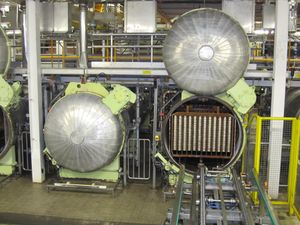Wet Pet Food Manufacturing
Overview
Wet foods are made by mixing recipe ingredients together and cooking them within the can, tray or pouch. The food in the container then remains sterile for the shelf life of the product or until opened. These products can be in the form of chunks in gravy, sauce or jelly, loaf or mousse.
Ingredient Selection
Many of the ingredients used in the manufacture of pet food are described as animal (or fish) derivatives or by-products. These ingredients are the parts of the animal surplus to the requirements of the human food industry. Examples of by-products include liver, kidney, lung and various meat by-product meals. Pet foods may also use ingredients legally defined as meat (muscle meat). These ingredients are also most commonly found within the human food chain. In wet pet foods, by-products arrive at the factory in a fresh or frozen state. They may be chopped and added to the recipe mix directly or finely minced, mixed with dry ingredients such as cereals, formed into ribbons and diced into chunks of various sizes and shapes. Other ingredients are included such oils and fats, vitamins, minerals, cereals, pasta, grains, or vegetables. Water is also frequently added as an ingredient to facilitate processing and to give the food its final form and texture.
Ingredient Weighing and Preparation
Ingredients are carefully selected according to a pet food manufacturer’s specific recipe, which is formulated to deliver complete and balanced nutrition for cats and dogs and also to meet other requirements of the product such as the variety, age range or size range.
Once the ingredients for a specific recipe are mixed they enter the can, pouch or tray. For some forms of wet food, a mix of water, thickening agents and flavours may be added to form a gravy or jelly during the cooking process.
Sealing and Cooking
The can, pouch or tray is then sealed and enters a cooking process. The temperature and length of cooking are carefully controlled in order to prevent spoilage over the shelf life of the product, as well as to optimise the taste and protect the required nutritional content.
Cooling and Labelling
After the cooked products are cooled, cans are labelled. Information on tray and pouch products is usually printed upon the packaging itself.
Storage and Distribution
Individual containers are packed into boxes or trays and stored in warehouses and undergo quality assurance testing before being dispatched to customers.
| This article was: Date reviewed: April 2017 |
| Endorsed by Mars Petcare, the world’s leading pet nutrition and health care business that strives to make A Better World for Pets every day. | 
|

